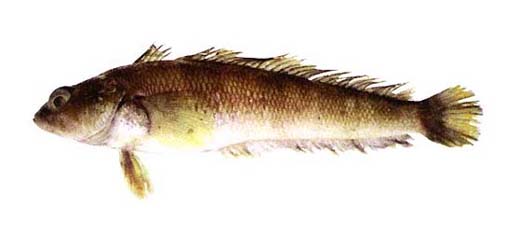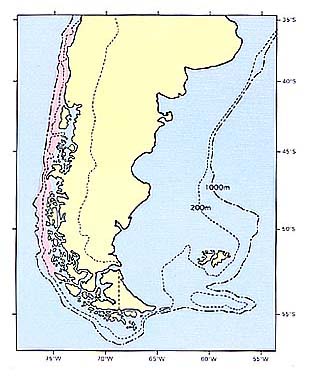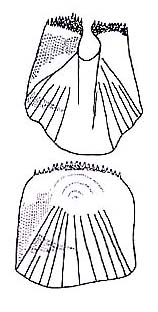ノトセニア科
- HOME
- デジタル図鑑
- パタゴニア海域の重要水族
- 硬骨魚綱 スズキ目
- ノトセニア科
ノトセニア科(Nototheniidae)

97 アシナガノトセニア(Ashinaga-notosenia)
Patagonotothen longipes(Steindachner, 1876)
特 徴:
背鰭6棘,32~35軟条,臀鰭31~33軟条,胸鰭25~28軟条,腹鰭1棘,5軟条,鰓耙数9~12+0~1+14~17=24~29,鰓条骨数6,側線鱗数43~54(上列),10~19(下列),脊椎骨数16~18+35=51~53。頭長は体長の28.5~30.6%,眼径は6.9~7.2%,体高は20.0~22.8%,吻長は7.1~8.5%,両眼間隔は3.4~5.0%,上顎長は9.7~10.5%,尾柄高は7.9~8.5%,胸鰭長は17.9~20.4%,腹鰭長は15.5~17.5%,第1背鰭高は7.4~11.1%,第2背鰭高は9.4~13.3%,臀鰭高は6.3~7.8%,体は延長して体高は低く,側扁する。両眼間隔域は狭く,4~6列の小鱗が不規則に並ぶ。吻は眼径よりやや長い。口は小さく,両顎はほぼ同長。上顎後端は眼の前縁をわずかに越える。両顎歯は歯叢をなし,歯はきわめて小さいが,外側歯はやや大きい。鋤骨と口蓋骨は無歯。鰓耙は短くて太い。体側鱗は弱い櫛鱗で,やや不規則に並ぶ。頭部の小鱗は櫛鱗と円鱗からなる。胸鰭は短く,丸味を帯びる。成魚では腹鰭は胸鰭よりわずかに短く,若魚ではその逆,腹鰭は胸鰭よりかなり前方に位置する。第1背鰭は低く,ほぼ頭長の1/3に等しく,基底は短い。第2背鰭は第1背鰭と同高で,基底は長い。臀鰭は第2背鰭よりもやや低く,その基底は長い。側線は2列,上列は長く,鰓蓋上縁上に発し,ゆるやかに湾曲しつつ背縁に平行に尾柄部まで走る。下列は短く,尾部後方の体側中央を直走する。体長は約25cmに達する。
分 布:
チリ パタゴニア,チリ中部以南沖からマゼラン海峡西部海域付近に至る陸棚から陸棚斜面にかけて広く分布する。
備 考:
本種はP. ramsayiおよびP. wiltoniと極めてよく似る。とくに前者との類似は顕著で、DeWitt(1966)はP. longipesとP. ramsayiを亜種段階で区別した。白身で肉質は良好だが、魚体が小さく、歩留りが小さい。
(中村 泉)
Material examined:
10 from Chile(140.2-241.0 mm SL), FAKU CP 15, 154, 354-357, 359, 360, 367, 589.
Description:
D Ⅵ, 32-35; A31-33; P125-28; P2Ⅰ, 5; GR9-12+0-1+14-17=24-29; BS6; LLS43-54(upper), 10-19(lower); V16-18+35=51-53. HL28.5-30.6% of SL; ED6.9-7.2; BD20.0-22.8; SN7.1-8.5; IO3.4-5.0; UJ9.7-10.5; CP7.9-8.5; P1L17.9-20.4; P2L15.5-17.5; D1H7.4-11.1; D2H9.4-13.3; AH6.3-7.8.
Body elongate, compressed, by body depth 4.4-5.0 times in SL. Head small, 3.3-3.5 times in SL. Interorbital region narrow, with 4-6 rows of scales between eyes, its width fairly smaller than eye diameter. Snout longer than eye diameter. Mouth small. Posterior end of uppper jaw slightly extending to anterior to anterior margin of eye. Small jaw teeth in bands, those of outer row slightly enlarged, especially anteriorly. Gill-rakers short, robust. Pseudobranchiae present. Nostril single, with a tube-like flap around. Upper surface of head, cheeks and opercles covered with weak ctenoid or cycloid scales. Tow lateral lines present. Pectoral fin round and slightly longer than pelvic fin. Pelvic fin situated anterior to pectoral fin origin, its tip not reaching to anus. Caudal peduncle depth about equal to snout length. Margin of caudal fin convex. First dorsal fin low with short base, its height about 1/3 of head. Second dorsal fin nearly same height as first dorsal fin. Anal fin base slightly shorter than second dorsal fin base. General color of body similar to that of P. ramsayi, but slightly darker.
Distribution:
Chilean Patagonia.
Remarks:
This species together with Patagonotothen ramsayi, and P. wiltoni form the longipes complex as recognized by Regan(1913) and DeWitt(1966).
(Izumi NAKAMURA)

Distribution of Patagonotothen longipes in Patagonia.

Laterla line scale(above) and scale below lateral line(below).